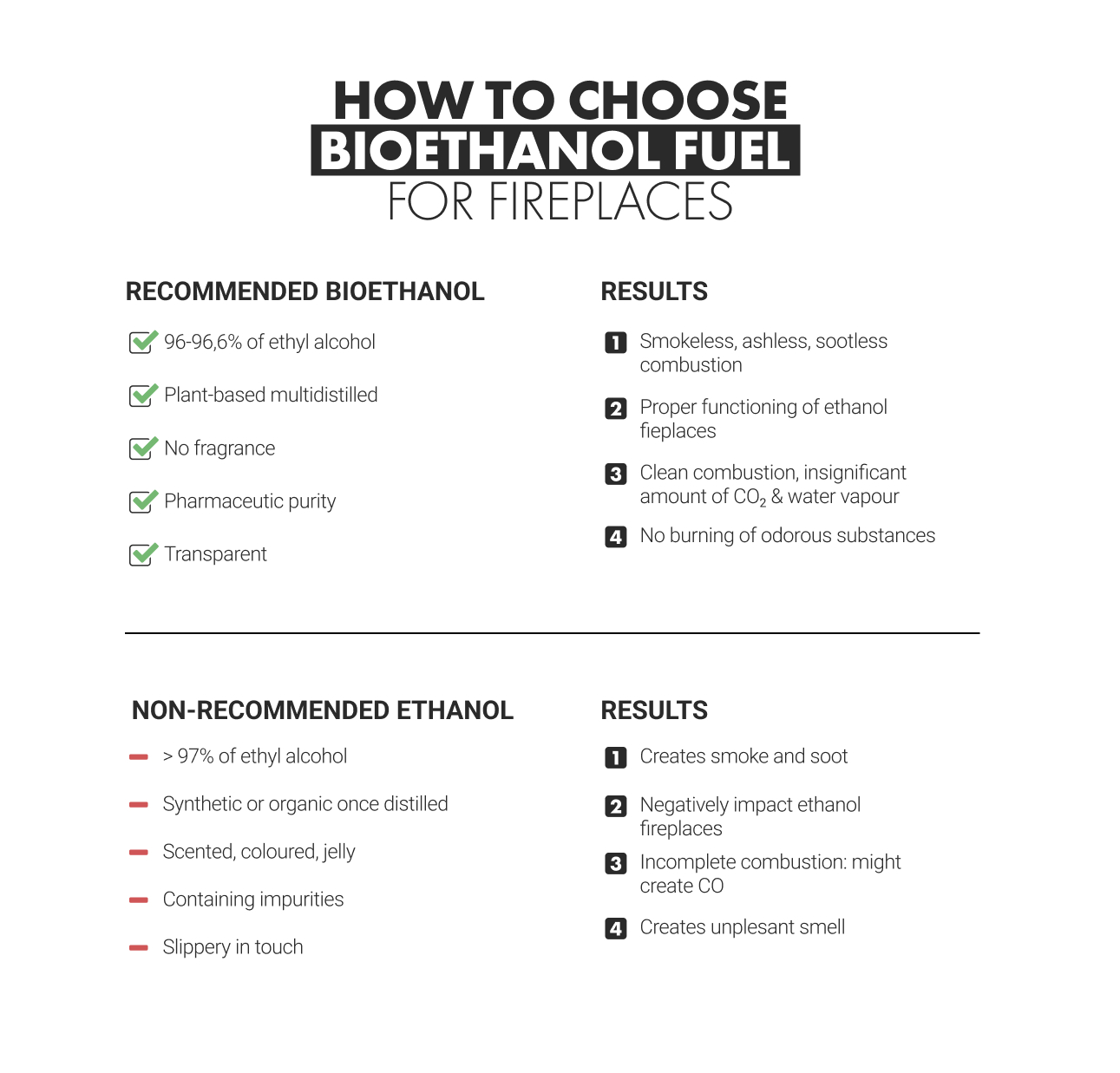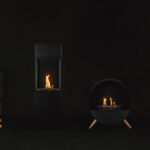WHAT IS THE BEST BIOETHANOL FUEL FOR FIREPLACES – BUYER’S GUIDE
Bio fireplaces are becoming more and more popular, that’s why the number of bioethanol fuel manufacturers grows too. The origin of the fuel might differ and it influences its qualities. Are you sure, you can choose the bioethanol fuel that is right for your fireplace?
1. WHAT IS BIOETHANOL FOR FIREPLACES?
Bioethanol is plant-based ethanol, for centuries known also as ethyl alcohol (C2H5OH) is a transparent, odorless liquid that can be combusted.
Only a 96.6% multiply rectified ethanol of pharmaceutical grade purity is appropriate for combustion in fireplaces.


2. COMBUSTION IN BIOETHANOL FIREPLACES – MANUAL & AUTOMATIC WITH BEV TECHNOLOGY
Although ethanol is mostly known for the production of alcoholic beverages, it can be also used as a fuel for bioethanol fireplaces.
a) COMBUSTING BIOETHANOL IN MANUAL FIREPLACES
Using bioethanol fuel in manual fireplaces has its pros and cons. To light up the fire in manual fireplaces, pour the fuel into the trough and light the fire. It’s an easy and quick process. However, the flame has direct contact with the fuel and starts to boil. In the case of manual fireplaces, where the fuel is in direct contact with the flame, once the temperature reaches approximately 80°C, vapors begin to emerge. Some of them are emitted into the room.
b) COMBUSTING BIOETHANOL IN AUTOMATIC FIREPLACES WITH BEV TECHNOLOGY
This phenomenon doesn’t happen in automatic bioethanol fireplaces, because they rely on the BEV (Burning Ethanol Vapours) Technology. The liquid bioethanol is turned into ethanol vapours by the vapour generator. Then the vapours are transported to the burner and combusted. The ethanol vapours are combusted completely, thus there is no unpleasant smell in the room and no efficiency losses. Using 100% bioethanol fuel for automatic fireplaces is not recommended, because it can damage the electrical components inside the fireplace.
3. IS BIOETHANOL AN ECO-FRIENDLY FUEL?
The by-products of bioethanol combustion are water vapour and an insignificant amount of CO2. This carbon dioxide can be then absorbed by the plants. This Net Zero combustion process is a significant advantage compared to other heating options – especially those based on fossil fuels.
4. HOW TO CHOOSE BIO ETHANOL FUEL FOR FIREPLACES?
When buying a fuel, pay attention to these information on the label:
- bioethanol made of plants in a process of multiple rectification,
- 96-96,6% of ethyl alcohol,
- pharmaceutical purity.
This information can be found on the label of the bioethanol bottle or in the safety data sheet. The safety data sheet is a mandatory document provided by the manufacturer. It contains information on chemical composition, properties, transport guidelines and others that comply with EU regulations.
Low-quality bioethanol fuels are also available on the market, even though they have all the important information on the label. Be sure not to buy bioethanol fuels that are gelled, scented or dyed. The more gelled and odoriferous substances in the composition of bioethanol, the greater the likelihood of burning these substances and giving off an unpleasant odor.
5. WHERE TO BUY BIO ETHANOL FUEL?
Bioethanol fuel is now a generally accessible product that can be purchased:
- in a manufacturer online store,
- on the marketplaces, like Amazon,
- from the fireplace dealer,
- local construction store.
6. CONSUMPTION AND PRICE
The consumption of the bioethanol fuel depends on the length of the burner and the height level of the flame (this one can be regulated in automatic burners with BEV Technology). An approximately 1 m long burner can consume around 1 l of the bioethanol fuel per hour.
With an average European purchase price, operating costs of around €4.5 per hour. In case of longer burners, the costs grow proportionally.
The type of fireplace also influences the consumption of bioethanol fuel. Automatic fireplaces with BEV Technology save up to 20% of the bioethanol fuel compared to their manual counterparts. This is because biofuel in manual fireplaces, the bioethanol fuel partly evaporates into the room. In case of automatic fireplaces with BEV Technology 100% of the fuel is turned into vapours and burnt. There is also another difference between manual and automatic fireplaces with BEV Technology. The latter fireplaces pump back the unused liquid ethanol from the vapour generator to the main tank. Meanwhile in the manual fireplace, the ethanol fuel still evaporates.
7. HOW IS BIOETHANOL MADE?
Bioethanol fuels can be divided into those of plant origin and synthetic ones.
Plant-based fuels are extracted from agricultural products such as wheat, sugar cane, sugar beet, etc. In the first stage, fermentation of the saccharides takes place, resulting in acquiring a mash. In a further stage, the mash undergoes a distillation process that produces 92% ethanol and CO2. After the distillation process, the ethanol undergoes a multiple rectification process, thanks to which it is purified and fortified. Such ethanol has a strength of 96.6%. In the final stage, substances are added to the ethanol to make the spirit unsuitable for consumption. Only such fuels are recommended for bio-fires.
Plant-based bioethanol can also be dehydrated using atomic sieves. Such alcohol has a strength of 100%. It is not recommended because the higher alcohols it contains cause high impurities. As a result, these impurities can cause an unpleasant odour and react with the components of an automatic BEV fireplace and lead to their damage.
There are also ethanol fuels on the market that are synthetically derived from ethylene, a product of petroleum refining. Therefore, when using this type of fuel, a peculiar odor may be emitted and may adversely affect the sensors in the automatic fireplace by Planika.
8. WHAT ARE THE ADVANTAGES OF BIOETHANOL FUEL
Even though the price of the bioethanol migth be slightly higher, it has multiple benefits:
- no smoke, soot or ash,
- carbon-neutrality,
- a renewable source of energy,
- bioethanol fireplaces don’t require the installation of a vent,
- can be used in cities that ban burning solid fuels.

9. WHICH BIOETHANOL FUEL IS THE BEST? SUMMARY
In conclusion, bioethanol fuel is plant-based alcohol that can be also used for fireplaces. Despite a vast offer of the fuels on the market, the best ones are:
- only made of plants,
- is multidistilled,
- with the 96-96,6% ethyl alcohol concentration,
- is transparent & non-scented,
- with pharmaceutical purity.
Only when using these bioethanol fuels, the combustion is clean, safe and doesn’t produce an unpleasant smell.




